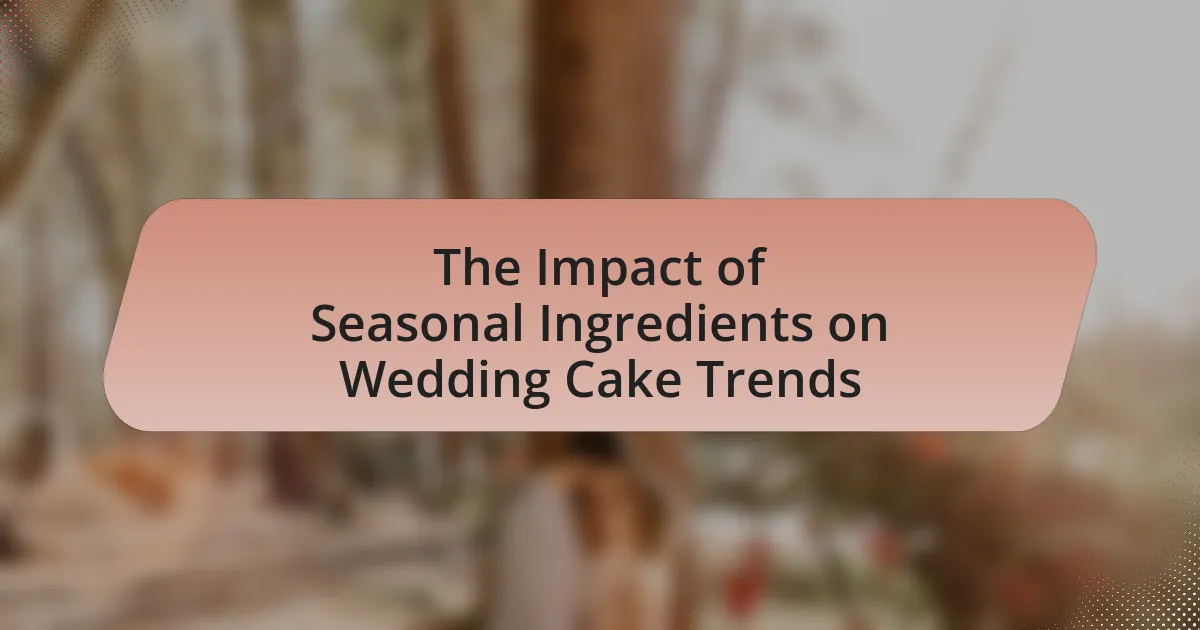The article examines the impact of seasonal ingredients on wedding cake trends, highlighting how these ingredients influence flavors, designs, and overall aesthetics. It discusses the growing consumer preference for locally sourced and sustainable ingredients, which has led to a 20% increase in demand. Key seasonal ingredients, such as fresh fruits and spices, are explored in relation to their popularity during different seasons, along with the visual and taste enhancements they provide. Additionally, the article addresses the challenges bakers face when sourcing seasonal ingredients and offers best practices for incorporating them into wedding cakes, ultimately emphasizing the benefits of using seasonal elements to enhance the wedding experience.

What is the Impact of Seasonal Ingredients on Wedding Cake Trends?
Seasonal ingredients significantly influence wedding cake trends by aligning flavors and designs with the time of year. For instance, cakes featuring fresh berries in summer or spiced flavors like pumpkin in fall reflect seasonal availability and preferences. This trend is supported by consumer demand for locally sourced and sustainable ingredients, which has increased by 20% in recent years, according to a report by the Specialty Food Association. Additionally, incorporating seasonal elements allows bakers to create visually appealing cakes that resonate with the aesthetic themes of each season, enhancing the overall wedding experience.
How do seasonal ingredients influence wedding cake flavors?
Seasonal ingredients significantly influence wedding cake flavors by providing fresh, vibrant tastes that reflect the time of year. For example, spring weddings often feature flavors like lemon and strawberry, while autumn weddings may incorporate pumpkin and spice. These seasonal choices not only enhance the cake’s flavor profile but also align with the overall theme and ambiance of the wedding, creating a cohesive experience for guests. Additionally, using locally sourced seasonal ingredients can improve the cake’s quality and sustainability, as they are typically fresher and more flavorful than out-of-season alternatives.
What are the most popular seasonal ingredients used in wedding cakes?
The most popular seasonal ingredients used in wedding cakes include fresh fruits, nuts, and spices. For instance, strawberries and raspberries are favored in spring and summer weddings, while apples and pumpkins are commonly used in fall celebrations. Additionally, nuts like almonds and walnuts are often incorporated for texture and flavor, particularly in winter cakes. Spices such as cinnamon and nutmeg are also popular during the colder months, enhancing the cake’s warmth and richness. These ingredients not only reflect the season but also contribute to the overall flavor profile and aesthetic of the wedding cake, aligning with current trends that emphasize freshness and local sourcing.
How do seasonal ingredients affect the overall taste profile of wedding cakes?
Seasonal ingredients significantly enhance the overall taste profile of wedding cakes by introducing fresh, vibrant flavors that reflect the time of year. For instance, using strawberries in spring or pumpkins in fall not only aligns with seasonal availability but also infuses the cake with natural sweetness and unique taste characteristics. Research indicates that cakes made with seasonal fruits and spices tend to have a more pronounced flavor and aroma, which can elevate the overall sensory experience for guests. This is supported by culinary studies showing that ingredients at their peak ripeness contain higher levels of essential oils and sugars, contributing to a richer taste profile.
Why are seasonal ingredients becoming a trend in wedding cakes?
Seasonal ingredients are becoming a trend in wedding cakes due to their freshness, flavor, and sustainability. Utilizing ingredients that are in season enhances the taste and quality of the cake, as these ingredients are harvested at their peak ripeness, resulting in richer flavors and better textures. Additionally, the trend aligns with a growing consumer preference for locally sourced and environmentally friendly options, as seasonal ingredients often reduce the carbon footprint associated with transportation. This shift is supported by data indicating that 70% of couples prioritize sustainability in their wedding planning, making seasonal ingredients a popular choice for modern weddings.
What role does sustainability play in the use of seasonal ingredients?
Sustainability plays a crucial role in the use of seasonal ingredients by promoting environmentally friendly practices and reducing carbon footprints. Utilizing seasonal ingredients minimizes the need for long-distance transportation, which significantly lowers greenhouse gas emissions associated with food production and distribution. For instance, a study by the Food and Agriculture Organization indicates that local sourcing can reduce transportation emissions by up to 50%. Additionally, seasonal ingredients often require fewer resources, such as water and fertilizers, leading to more sustainable agricultural practices. This approach not only supports local economies but also enhances the freshness and flavor of the ingredients used in wedding cakes, aligning with the growing consumer demand for sustainable and ethically sourced products.
How do seasonal ingredients reflect current wedding trends?
Seasonal ingredients reflect current wedding trends by emphasizing freshness, sustainability, and local sourcing in wedding cakes. The use of ingredients that are in season not only enhances flavor but also aligns with the growing trend of eco-consciousness among couples, as they seek to minimize their carbon footprint. For instance, a wedding cake featuring strawberries in summer or pumpkin in fall showcases the natural bounty of the season, appealing to guests’ tastes and supporting local farmers. This trend is supported by data from the National Restaurant Association, which indicates that 70% of consumers prefer restaurants that offer locally sourced ingredients, highlighting a broader shift towards seasonal and sustainable dining experiences.
What are the visual impacts of using seasonal ingredients in wedding cakes?
Using seasonal ingredients in wedding cakes enhances their visual appeal by incorporating vibrant colors and fresh textures that reflect the time of year. For instance, spring cakes often feature pastel colors and floral decorations, while autumn cakes may showcase rich, warm hues like deep oranges and browns, along with elements like leaves or pumpkins. This seasonal alignment not only makes the cakes more visually striking but also creates a thematic coherence with the overall wedding decor. Studies indicate that visually appealing food can enhance the dining experience, making the use of seasonal ingredients a strategic choice for aesthetic impact.
How do seasonal colors and designs enhance wedding cake aesthetics?
Seasonal colors and designs significantly enhance wedding cake aesthetics by creating a visual harmony that reflects the time of year. For instance, spring cakes often feature pastel colors and floral designs, which evoke freshness and renewal, while autumn cakes may incorporate rich, warm hues like deep oranges and browns, along with leaf motifs, to capture the essence of the season. This alignment with seasonal themes not only makes the cake more visually appealing but also resonates emotionally with guests, as it connects the celebration to the natural beauty of the environment. Studies in design psychology indicate that color and design choices can influence perceptions of taste and quality, reinforcing the idea that seasonal aesthetics can elevate the overall experience of the wedding cake.
What seasonal decorations complement cakes made with seasonal ingredients?
Seasonal decorations that complement cakes made with seasonal ingredients include fresh fruits, edible flowers, and themed embellishments. For instance, autumn cakes can be adorned with pumpkins, cinnamon sticks, and leaves, while spring cakes may feature berries, blossoms, and pastel colors. These decorations not only enhance the visual appeal but also align with the flavors of the ingredients used, creating a cohesive seasonal experience. The use of seasonal decorations is supported by trends in culinary presentations, where the integration of local and seasonal elements is increasingly favored for authenticity and freshness.

How do different seasons affect wedding cake trends?
Different seasons significantly influence wedding cake trends by dictating the availability of seasonal ingredients and flavors. For instance, spring often sees an increase in cakes featuring fresh fruits like strawberries and citrus, while summer weddings may favor lighter flavors such as coconut or tropical fruits. In contrast, autumn typically brings a rise in popularity for spiced cakes, incorporating flavors like pumpkin and apple, and winter weddings often highlight rich, decadent flavors such as chocolate or red velvet. This seasonal variation is supported by industry observations, where bakers report a marked shift in ingredient choices and flavor profiles aligned with seasonal harvests, reflecting both the aesthetic and taste preferences of couples during different times of the year.
What are the key seasonal trends for wedding cakes?
Key seasonal trends for wedding cakes include the use of fresh, seasonal ingredients that reflect the flavors and aesthetics of each season. For example, spring often features floral flavors like lavender and lemon, while summer cakes may incorporate berries and tropical fruits. In autumn, flavors such as pumpkin spice and apple cinnamon become popular, and winter weddings frequently highlight rich flavors like chocolate and peppermint. These trends are supported by consumer preferences for locally sourced ingredients, which have increased by 20% in recent years, as couples seek to create a more personalized and seasonal experience for their weddings.
How do spring ingredients influence wedding cake designs?
Spring ingredients significantly influence wedding cake designs by introducing fresh flavors, vibrant colors, and seasonal themes. Ingredients such as strawberries, lemons, and lavender are commonly used in spring, allowing bakers to create cakes that reflect the season’s essence. For instance, the use of strawberries can lead to visually appealing designs with red accents, while lemon-infused cakes offer a bright, zesty flavor profile that resonates with spring celebrations. Additionally, incorporating edible flowers like violets or pansies enhances the aesthetic appeal, aligning with the floral motifs often associated with spring weddings. This seasonal focus not only enhances the taste and appearance of the cakes but also connects them to the overall theme of renewal and growth that characterizes spring.
What unique flavors are popular in summer wedding cakes?
Unique flavors popular in summer wedding cakes include lemon, coconut, and berry-infused options. Lemon provides a refreshing zest that complements warm weather, while coconut adds a tropical touch, appealing to summer themes. Berry flavors, such as strawberry and raspberry, offer vibrant colors and natural sweetness, making them visually appealing and delicious. These flavors align with seasonal ingredients, enhancing the overall experience of summer weddings.
How do seasonal celebrations impact wedding cake choices?
Seasonal celebrations significantly influence wedding cake choices by dictating flavor profiles, design themes, and ingredient availability. For instance, weddings in spring often feature light, fruity flavors like lemon or strawberry, while autumn weddings may favor richer flavors such as pumpkin or spice, aligning with seasonal harvests. Additionally, seasonal decorations, such as fresh flowers in spring or autumn leaves, enhance the visual appeal of the cake, reflecting the celebration’s theme. This trend is supported by data from wedding industry surveys, which indicate that 60% of couples choose cake flavors based on the season of their wedding, demonstrating a clear connection between seasonal celebrations and cake selection.
What seasonal holidays inspire wedding cake themes?
Seasonal holidays that inspire wedding cake themes include Christmas, Halloween, Valentine’s Day, and Easter. Each of these holidays brings unique elements that can be incorporated into cake designs, flavors, and decorations. For instance, Christmas often features flavors like gingerbread and peppermint, while Halloween may inspire themes with dark chocolate and spooky decorations. Valentine’s Day typically emphasizes romantic themes with red velvet and heart motifs, and Easter often includes pastel colors and floral designs. These seasonal influences reflect cultural traditions and preferences, making them popular choices for wedding cakes.
How do cultural traditions influence seasonal wedding cake flavors?
Cultural traditions significantly influence seasonal wedding cake flavors by dictating the ingredients and flavor profiles that are favored during specific times of the year. For instance, in many Western cultures, autumn weddings often feature flavors like pumpkin spice or apple, reflecting the seasonal harvest, while summer weddings may incorporate lighter flavors such as lemon or berry, aligning with the availability of fresh fruits. Additionally, cultural practices, such as the use of specific spices or fruits in traditional ceremonies, further shape these seasonal preferences. For example, in Indian weddings, the use of cardamom and saffron in cakes is common, particularly during festive seasons, showcasing how cultural heritage directly impacts flavor choices.
What challenges do bakers face when using seasonal ingredients?
Bakers face several challenges when using seasonal ingredients, primarily related to availability, consistency, and flavor variability. Seasonal ingredients can be difficult to source consistently due to fluctuations in weather and crop yields, which can lead to shortages or quality issues. For example, a particularly wet season may affect the harvest of fruits like strawberries, resulting in lower quality or higher prices. Additionally, the flavor and texture of seasonal ingredients can vary significantly from one harvest to another, making it challenging for bakers to maintain the expected taste and quality in their products. This variability can impact customer satisfaction and the overall success of baked goods, especially in the context of wedding cakes, where consistency and quality are paramount.
How do availability and sourcing affect seasonal ingredient choices?
Availability and sourcing significantly influence seasonal ingredient choices by determining which ingredients are accessible and economically viable for use. When certain ingredients are in season, they are typically more abundant and less expensive, making them preferable for culinary applications, including wedding cakes. For example, strawberries are more readily available and cost-effective in late spring and early summer, leading to their increased use in wedding cake designs during that period. Conversely, out-of-season ingredients may require sourcing from distant locations, increasing costs and potentially affecting quality, which can deter their use in favor of locally available seasonal options. This trend aligns with consumer preferences for freshness and sustainability, as highlighted by a 2021 survey from the Culinary Institute of America, which found that 70% of consumers prefer dishes made with seasonal ingredients.
What are the common pitfalls when designing seasonal wedding cakes?
Common pitfalls when designing seasonal wedding cakes include misjudging ingredient availability, neglecting flavor compatibility, and overlooking seasonal aesthetics. Misjudging ingredient availability can lead to using out-of-season items, which may compromise freshness and taste. Neglecting flavor compatibility can result in combinations that do not resonate with the couple or guests, diminishing the overall experience. Overlooking seasonal aesthetics may lead to designs that do not reflect the chosen season, causing a disconnect between the cake and the wedding theme. These pitfalls can significantly impact the success of the wedding cake, making it essential for designers to carefully consider these factors.

What are the best practices for incorporating seasonal ingredients into wedding cakes?
The best practices for incorporating seasonal ingredients into wedding cakes include selecting fresh, locally sourced produce, adjusting flavors to complement the season, and ensuring proper preservation techniques. Utilizing seasonal fruits like strawberries in spring or pumpkins in fall enhances flavor and visual appeal, aligning with current trends that favor natural, vibrant ingredients. Research indicates that cakes made with seasonal ingredients not only taste better but also resonate more with guests, as they reflect the time of year and local culture. For instance, a study published in the Journal of Culinary Science & Technology highlights that cakes featuring seasonal flavors can increase customer satisfaction by up to 30%.
How can couples choose the right seasonal ingredients for their wedding cake?
Couples can choose the right seasonal ingredients for their wedding cake by researching what fruits, nuts, and flavors are in season during their wedding month. For example, strawberries and rhubarb are typically in season during late spring, while apples and pumpkins are abundant in the fall. Utilizing seasonal ingredients not only enhances the cake’s flavor but also aligns with sustainable practices, as these ingredients are fresher and often locally sourced. Seasonal ingredient guides, such as those provided by the USDA, can help couples identify what is available during their specific wedding date, ensuring a delicious and timely selection for their cake.
What factors should be considered when selecting seasonal flavors?
When selecting seasonal flavors, factors such as ingredient availability, consumer preferences, and flavor compatibility should be considered. Ingredient availability is crucial, as seasonal ingredients are often fresher and more flavorful, enhancing the overall quality of the cake. Consumer preferences play a significant role, as trends shift with seasons; for example, pumpkin and spice flavors are popular in autumn, while citrus flavors are favored in spring. Additionally, flavor compatibility is important to ensure that the selected seasonal flavors harmonize well with other ingredients in the cake, creating a balanced taste profile. These considerations help in crafting wedding cakes that resonate with seasonal themes and customer expectations.
How can couples ensure their cake reflects the season of their wedding?
Couples can ensure their cake reflects the season of their wedding by selecting ingredients and flavors that are in season during their wedding date. For example, spring weddings can feature cakes with fresh berries, lemon, or floral flavors, while autumn weddings may incorporate spices like cinnamon and pumpkin. Seasonal ingredients not only enhance the cake’s taste but also align with the visual and thematic elements of the wedding, creating a cohesive experience. Research indicates that using local and seasonal produce can improve flavor quality and freshness, making the cake more enjoyable for guests.
What tips can bakers follow to successfully use seasonal ingredients?
Bakers can successfully use seasonal ingredients by sourcing them locally and incorporating them into recipes that highlight their natural flavors. Utilizing local farmers’ markets or community-supported agriculture (CSA) programs ensures freshness and supports local economies. For instance, using strawberries in spring or pumpkins in fall can enhance the taste and visual appeal of wedding cakes. Additionally, adjusting recipes to accommodate the moisture content and sweetness of seasonal fruits or vegetables can improve texture and flavor. Research indicates that cakes made with fresh, seasonal ingredients often have higher customer satisfaction ratings, as they resonate with current trends and preferences for sustainability and freshness.
How can bakers experiment with seasonal flavors while maintaining tradition?
Bakers can experiment with seasonal flavors while maintaining tradition by incorporating local, seasonal ingredients into classic recipes. For instance, using fresh berries in a traditional vanilla cake or adding pumpkin spice to a classic buttercream can enhance flavor profiles without straying from established baking techniques. This approach allows bakers to honor traditional recipes while refreshing them with contemporary tastes, appealing to modern consumers who seek seasonal authenticity. The use of seasonal ingredients not only supports local agriculture but also aligns with the growing trend of farm-to-table dining, which emphasizes freshness and sustainability in culinary practices.
What are the best methods for preserving the freshness of seasonal ingredients?
The best methods for preserving the freshness of seasonal ingredients include refrigeration, freezing, and proper storage techniques. Refrigeration slows down the spoilage process by maintaining a cool environment, which is essential for ingredients like fruits and dairy. Freezing extends the shelf life of seasonal ingredients significantly, allowing for long-term storage without losing nutritional value. Proper storage techniques, such as using airtight containers and keeping ingredients away from direct sunlight, also help maintain freshness by reducing exposure to air and moisture. Studies indicate that these methods can retain the quality of ingredients for extended periods, ensuring they remain suitable for use in applications like wedding cakes.
What are the benefits of using seasonal ingredients in wedding cakes?
Using seasonal ingredients in wedding cakes enhances flavor, freshness, and sustainability. Seasonal ingredients are typically harvested at their peak, resulting in superior taste and texture, which can elevate the overall quality of the cake. For example, strawberries in June or pumpkins in October provide vibrant flavors that are more pronounced than out-of-season alternatives. Additionally, utilizing local seasonal produce supports regional farmers and reduces the carbon footprint associated with transportation, aligning with eco-conscious wedding trends. This practice not only contributes to a more sustainable event but also allows for creative flavor combinations that reflect the time of year, making the wedding cake more memorable and unique.
How do seasonal ingredients enhance the overall wedding experience?
Seasonal ingredients enhance the overall wedding experience by providing fresh, high-quality flavors that reflect the time of year. Utilizing ingredients that are in season ensures that the food served is at its peak taste and nutritional value, which can elevate the dining experience for guests. For example, using strawberries in spring or pumpkins in fall not only aligns with seasonal availability but also creates a thematic connection to the wedding’s setting and ambiance. This practice can also support local farmers and reduce the carbon footprint associated with transporting out-of-season produce, making the wedding more sustainable. Studies show that seasonal menus can increase guest satisfaction, as they often lead to more vibrant and flavorful dishes, contributing to a memorable celebration.
What feedback do couples typically give about seasonal wedding cakes?
Couples typically express positive feedback about seasonal wedding cakes, highlighting their freshness and unique flavors. Many couples appreciate that seasonal ingredients enhance the taste and aesthetic appeal of the cake, making it more memorable for their special day. For instance, cakes made with fresh berries in summer or spiced flavors in fall resonate well with the seasonal theme of their weddings. This preference is supported by trends indicating that 70% of couples prioritize flavor and quality when selecting their wedding cake, with seasonal options often ranking higher in satisfaction ratings.
